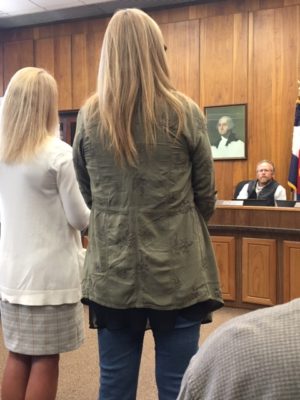The effort to solve Chaffee County’s affordable housing crisis will get a boost beginning in July from what some might see as an unlikely source. A $240,000 public health grant – pure grant monies because it did not require a local match – jointly applied for by the Chaffee County Department of Public Health and the Chaffee County Office of Housing. The first year of the program will gather community input to identify and prioritize efforts to improve the county’s housing situation.
“This is a really exciting opportunity because health equity isn’t necessarily embedded into housing and comprehensive plans,” said Chaffee County Department of Health Executive Director Andrea Carlstrom.
The funding will be used to implement evidence-based strategies, working on systems and policies that address housing and land use planning. Efforts will focus on housing affordability, reducing displacement, segregation and gentrification that displaces critical workforce. A secondary outcome, according to Carlstrom, is a more informed population ready to engage with the Chaffee County Planning Commission and its work on a new Chaffee Comprehensive Plan.

Chaffee County Public Health Executive Director Andrea Carlstrom, left, and Chaffee County Director of Housing Becky Gray outline the Health Equity grant program to Chaffee County Commissioners on Tuesday including Chair Greg Felt.
“We have an opportunity in front of us to increase our local capacity around housing,” said Chaffee County Office of Housing Director Becky Gray in a conversation following the meeting. “The three-mile area around the towns and cities – the intersection of a rural county and the municipalities — is where we can talk about a broad range of land uses. We can create a plan between the county and the jurisdictions about how the growth areas will look.”
Carlstrom, who has served on the county’s Housing Policy Advisory Committee since its inception, first identified the grant opportunity in January. She explains that public health policy officials have linked poor and in-secure housing conditions to health problems in adults and children. Those unsafe conditions and environmental circumstances can include issues ranging from lead-filled pipes, black mold, and dangerous electrical situations, to asbestos insulation, old lead paint and even the absence of any secure housing situation.
Carlstrom shared the grant idea with Gray and they worked together to submit the county’s application. The needs identified in the application included the results of the 2016 Chaffee County Housing Needs Assessment and the extensive effort by the Housing Policy Advisory Committee over the past two years to identify the extent of the county’s housing crisis and a focus on public education about the reasons it should be addressed.
A recent land use selection survey taken at Poncha Lumber’s Vendor Fair was the beginning of the grant’s information input process. That recent survey revealed two, top-of-mind issues.
“People want to know what are the financial implications of different development patterns – for instance they still want the county to look like a county – and [they want to know] what is happening to the middle housing market,” said Gray.
Nearly 30 different topic areas addressing housing solutions, and some 18 different opportunities to involve the public in the process of developing housing solutions have been identified. “Our department will be working with many of the county efforts underway, organizations protecting public lands … for instance the Recreation in Balance [team] and the Homeless Outreach team,” said Gray.
Upcoming opportunities for the public to weigh in on the Health Equities grant, include a free public event that will launch the effort for the new Chaffee County Comprehensive Plan, scheduled for 6 p.m. on June 26 at Mt. Princeton Hot Springs Resort Conference Center.
Input from the Planning Commission will be sought throughout June. The survey will be available for public participation at the Chaffee County Building Department front desk. More avenues to distribute the survey are being sought, including the Chaffee County Economic Development Corporation, Envision and the Chaffee County Health Coalition. Commissioner Rusty Granzella suggested to Gray that contacting finance institutions – those that focus on low-income financing might be a good information source.
“We’ve been talking about affordable housing, but I’ve also had people come up to me and ask ‘but what about the middle pocket of housing so families can live here?’” said Carlstrom.
“The missing middle housing is one of the things that is a prime topic for belts around the metro area. What about your message with this?” said Commissioner Keith Baker. He went on to bring up the need to integrate solutions for homeless veterans into the mix and Gray agreed.
“The timing of this couldn’t be better to synergize our efforts with the development of the new [county] Comprehensive Plan,” said Carlstrom.
“This $240,000 [grant] is amazing,” said Commissioner Greg Felt. “That’s how much we have cobbled together for the whole comp plan. A question – so most of this grant is for the subject matter experts. It crosses my mind that this program as we were just discussing ought to be synergized and organized with the comp plan. This wasn’t specifically part of what the [comp plan] consultant bid on, but there could be an opportunity to compensate them for doing some additional work to integrate this [grant focus] into the rest of the plan.
Felt recommended reaching out to the Arkansas Headwaters Recreation Area to attend the head guide meetings. “You’ll have the upper level of guides at that one [who can address their staff housing needs]. They can tell you what they are are or aren’t doing.”
Commissioners agreed that the opportunity for community engagement, weaving the grant addressing housing and health equity into the county’s land use code policies, might present an opportunity to address both short-term and long-term needs.
“Some of these topics, the public doesn’t know about, so we need to explain those to people,” said Baker.
“Our job will be to educate our community about some of these topics,” said Carlstrom. “People can’t prioritize a topic that they’ve never heard about before. We need to make sure we aren’t leaving a topic behind just because it didn’t rise to the top [in surveys].”
The commissioners agreed that the reporting format for the health equity grant to study housing needs will follow the time frame and process by which the progress on the preparation of the new county comprehensive plan will occur. Baker is the comp plan project manager representing the commissioners.
Image: courtesy of ‘HousingWorks Austin’.









Recent Comments